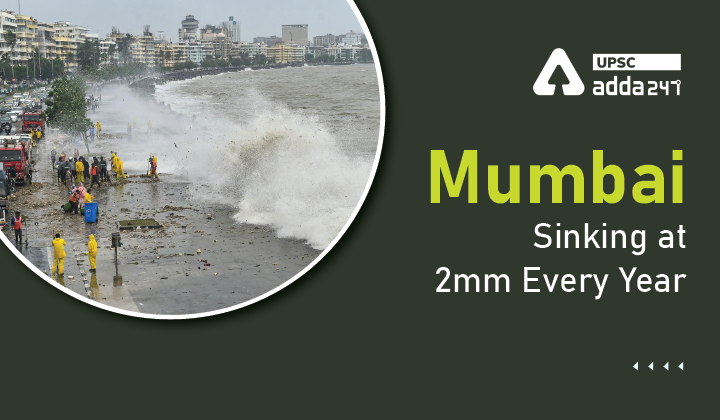Table of Contents
Mumbai Sinking 2mm: Relevance
- GS 3: Conservation, environmental pollution and degradation, environmental impact assessment.
Land subsidence: Context
- Recently, a study has found that Mumbai is sinking at an average rate of 2mm per year due to land subsidence.
Mumbai Sinking at 2mm Every Year: Key points
- The reason for sinking is a geological phenomenon known as land subsidence, which might lead to increased flooding unless urgent remedial action is taken by urban planners and municipal authorities.
- The study analysed land subsidence in 99 countries globally, and it found that Tianjin in China is the fastest sinking coastal city in the world at a rate of 5.2cm per year.
- Apart from Tianjin in China, other coastal cities ‘sinking’ include Jakarta in Indonesia, Shanghai in China, and Ho Chi Minh and Hanoi in Vietnam.
- Out of 46km2 of land in Mumbai, 19km2 is subsiding at a rate faster than 2mm/yr, with a maximum subsidence rate of 8.45mm/yr.
- Though the rate of subsidence in Mumbai is significantly lower than other countries in South Asia, it can over time compound the impacts of sea level rise and extreme rainfall events.
- Recent studies have also indicated that the Arabian Sea is rising by 0.5 to 3mm per year, suggesting that some parts of Mumbai may be sinking faster than sea levels are rising.
What is land subsidence?
- ‘Land subsidence’ refers to the downward, vertical movement of the earth’s surface.
- It can be caused by groundwater extraction, mining, reclamation of natural wetlands, infrastructure projects and ecological disturbances.
- Land subsidence is irreversible, and can adversely alter local hydrology, causing floods and damaging civic infrastructure like roads, railways, bridges, telecommunications and others.
Land subsidence at Mumbai: Issue
- Due to a prolonged decline of groundwater in the area that plays a crucial role in land subsidence along the coast, a considerable relationship between land subsidence and groundwater decline can be established over the region.
- With this declining groundwater, high-rise buildings, and metro development projects, Mumbai is becoming increasingly vulnerable to subsidence, leading to increased inundation.
- Nearly 38% of Mumbai’s land may be inundated during a normal rainfall. This is a severe issue that has to be addressed immediately.
Read current affairs for UPSC





 TSPSC Group 1 Question Paper 2024, Downl...
TSPSC Group 1 Question Paper 2024, Downl...
 TSPSC Group 1 Answer key 2024 Out, Downl...
TSPSC Group 1 Answer key 2024 Out, Downl...
 UPSC Prelims 2024 Question Paper, Downlo...
UPSC Prelims 2024 Question Paper, Downlo...





